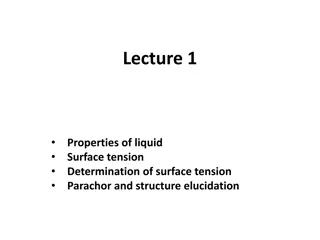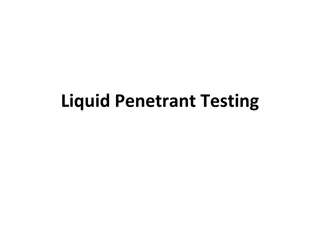Understanding Surface Tension: Properties, Measurement Methods, and Calculations
Surface tension is the pressure exerted by a liquid on its surface due to cohesive forces among molecules. The measurement methods include the liquid rise in a capillary tube technique, drop weight method, and bubble pressure method. The surface tension coefficient can be calculated using the equation involving gravitational pull, liquid height, density, and contact angle. Units for surface tension include N/m and dynes/cm, with water exhibiting high surface tension due to hydrogen bonding.
Download Presentation

Please find below an Image/Link to download the presentation.
The content on the website is provided AS IS for your information and personal use only. It may not be sold, licensed, or shared on other websites without obtaining consent from the author. Download presentation by click this link. If you encounter any issues during the download, it is possible that the publisher has removed the file from their server.
E N D
Presentation Transcript
Surface tension Surface tension pressure: it s the pressure exerted by a liquid on its surface. (Pa). Surface tension arises from cohesive forces between the liquid molecules. In the bulk, molecules are interacting equally with each other in all directions. However, at the surface, molecules don't have the same neighbors on all sides. Thus, a net inward force pulls the molecules toward the bulk. This gives rise to a property called surface tension. How high the surface tension is, is dependent on the type of molecular interactions present. For example, the surface tension of water is high, as the water molecules interact with each other through hydrogen bonds which are relatively strong.
Units of surface tension There are several different units for surface and interfacial tension; typically (N/m and dynes/cm) are used.
Measurements of surface tension There are several methods to measure surface tension: 1. liquid rise in capillary tube method. 2. Drop weight method. 3. Pubble pressure method. 4. Using tensiometer device.
liquid rise in capillary tube method. (1) We prepare the liquid whose surface tension is to be determined. We put it in a container (the density of that liquid is known, if not, it is measured using a density bottle of known volume). (2) We prepare a capillary tube open at both ends and with a known radius (r) and immerse one of its ends in the liquid. (3) We observe the rise of the liquid inside the capillary tube, and the liquid continues to rise inside the tube under the influence of surface tension forces (these forces act to reduce the surface area of the liquid). (4) At a certain height inside the capillary tube, the liquid stops rising. At this point, the liquid is under the influence of two forces that are equal in magnitude and opposite in direction, namely the surface tension forces, which push the liquid upwards, and the gravitational forces, which pull the liquid downwards. (5) We measure the height of the liquid inside the capillary tube, let it be h in cm or meters. Calculation method: When the liquid stops rising inside the capillary tube, the liquid is under the influence of two forces that are equal in magnitude and opposite in direction, namely: the downward pull due to gravity (the force of the liquid column) and the upward pull (surface tension forces). The equation of surface tension to be measured is: = ? ?? 2 cos
: Surface tension coefficient and its unit (dynes/cm) or (N/m). r: Radius of capillary tube in cm or m if the surface tension is measured in (N/m). h: Height of liquid in capillary tube (column height in cm) or can be in m if the surface tension is measured in (N/m). d: Density of liquid in (g/cm3) which is the same as (g/ml) or can be in (Kg/m3) if the surface tension is measured in (N/m). g: Acceleration due to gravity which is equal to (981 cm/s2) or can be (g = 9.81 m/s2). : Contact angle (for wetting liquids (such as water) it is nearly zero and (cos 0 = 1))
units Unit SI CGS Surface tension N/M Dyne/cm Height of liquid M Cm Kg/m3 gm/cm3or gm/ml Density of liquid 9.8 m/s2 981 cm/s2 Gravity Radius M cm
examples Example (1): If the radius of a capillary tube (r = 0.0335 cm) and when immersed in a liquid with a density (d = 0.866 g/cm3), the liquid rises in the capillary tube to a height of (h = 2.0 cm), and if you know that the acceleration due to gravity is (g = 981 cm/s2), calculate the surface tension of that liquid. The liquid makes convexity angle of 45 degree. Solution: Example (2): Calculate the height of the water inside a capillary tube with a radius of (r = 0.002 m) at a temperature of (300C), knowing that the density of water is (996 kg/m3) and the surface tension of water is (71.18 10-3 N/m) and the acceleration due to gravity is (9.81 m/s2) Solution:
Drop weight method This method is used to determine the surface tension of a liquid by knowing the surface tension of another known liquid, which is known as the reference liquid. - The device used for this purpose is called a stalagmometer, which is a capillary tube with a bubble, and a pipette can be used in the same way. - In this method, the surface tension values of two different liquids ( A, B) can be compared (A, B), where each of them passes individually through the same capillary tube, with the determination of the masses of the two drops (WA, WB) Accordingly: A B= ?? ??-------------- (1)
Experiment steps: . (1) (2) ) ( (A) ( A) (A) ( . (3) (4) (5) ) (WA) (B) (A) ) B) (B) (WB)
Calculations method dB, dA) . A, B) nB, nA) ( ( ( B) A) : ( ( ? WA= ???? ? ???? --------- (2) WB= A B=?? : ?? By substituting the values of WA, WB: ? ??.?? ? ??.?? ? ?= we get: ? ?= ?? .?? ??.??----------------------- (3)
Example: Find surface tension for a liquid A using drop weight method whish has 55 drops and density 0.8 g/cm3with water (B) which has 25 drops, density 0.996 g/cm3and surface tension ( ) of 72 dynes /cm.
Factors acting on surface tension temperature: when temperature increases, surface tension decreases. Impurities: when impurities increases, surface tension decreases. surfactants: Surfactants are compounds that can lower the surface tension of a liquid by adsorbing at the liquid-solid interface and reducing the cohesive forces between molecules.























